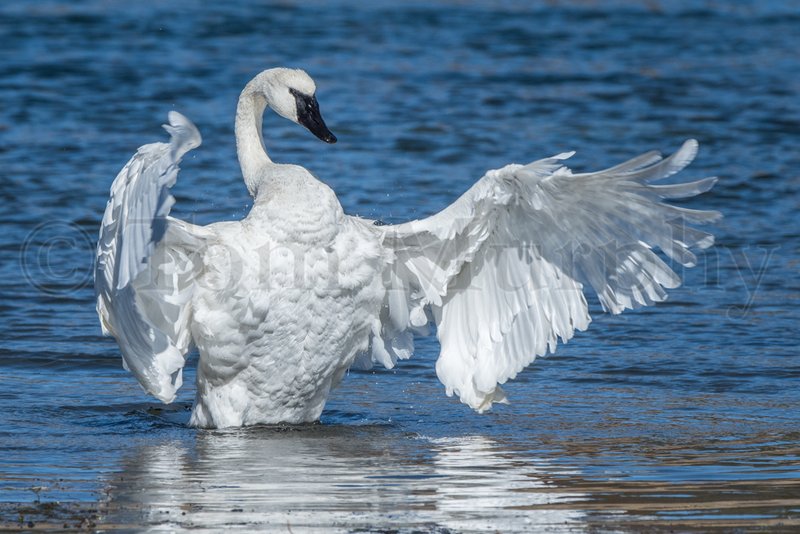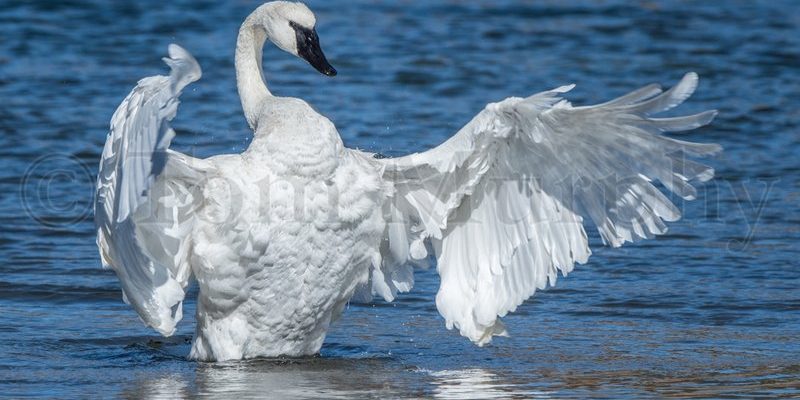
The Trumpeter Swan is one of the largest and most stunning waterfowl you’ll find in North America. Imagine a bird so beautiful that it looks like it stepped out of a fairytale. With its long neck, striking white plumage, and bold black bill, this bird captivates anyone who catches a glimpse. But there’s more to the Trumpeter Swan than just looks—it has a fascinating life story that unfolds across lakes and wetlands.
As you explore the world of the Trumpeter Swan, you’ll uncover its majestic habits, social structures, and even some of the threats it faces in the wild. Whether you’re already a birdwatching enthusiast or simply curious about wildlife, this article will take you on a journey through the life of one of nature’s most elegant birds.
Physical Characteristics
The Trumpeter Swan is known for its impressive size, often becoming a point of interest among bird watchers. Adult swans typically weigh between 20 to 30 pounds and have a wingspan that can reach up to 8 feet! Their sheer size can be quite staggering, making them the largest native waterfowl in North America. The plumage is entirely white, which makes them striking against the backdrop of blue water or green wetlands.
Their long necks give them a graceful appearance, and they often hold them elegantly while swimming or foraging. The most notable feature is their bill, which is a glossy black color, contrasting beautifully with their white feathers. Immature swans initially wear gray plumage, transitioning to the iconic white as they mature. This transformation can be likened to a caterpillar turning into a butterfly—it’s a remarkable journey.
Interestingly, Trumpeter Swans have a unique vocalization that sets them apart from other swans. They produce a deep, resonant trumpeting sound—hence their name! These calls can be heard during flight and are often used to communicate with their mates and family. You might hear them echoing across a serene lake, adding a musical touch to the environment.
Habitat and Range
Trumpeter Swans are typically found in the northern parts of North America, especially around lakes, rivers, and wetlands. They prefer areas with clean, open water that allows for easy access to their primary food sources, which include aquatic plants, roots, and tubers. These swans are not just picky eaters; they thrive in environments where they can forage comfortably and safely. They often create nests in marshy areas, making use of abundant vegetation.
During the breeding season, which usually occurs in spring, they migrate to freshwater habitats in Canada and Alaska. After nesting, they begin to move south for the winter, finding refuge in milder climates where the water doesn’t freeze. This migration isn’t just about the temperature; it’s a journey that signifies survival and the continuation of their species. Think of their migration as a long road trip, where careful planning ensures they reach their destination safely.
Interestingly, conservation efforts have allowed the Trumpeter Swan population to rebound from near extinction in the early 20th century. These birds can now be spotted in various locations across North America during their migration and breeding periods. Their adaptability has been crucial in reclaiming part of their former range, a testament to the importance of wildlife protection.
Diet and Feeding Habits
The diet of a Trumpeter Swan is primarily herbivorous, focusing on aquatic vegetation. They are known to dive and tip their bodies to feed on submerged plants, a behavior that can be both entertaining and mesmerizing to watch. They consume a variety of plants, such as sedges, pondweeds, and wild celery, which provide essential nutrients for their well-being. Imagine them gliding gracefully through the water, using their long necks to reach for delicious underwater snacks.
In addition to aquatic plants, Trumpeter Swans occasionally supplement their diet with grains and crops found in agricultural fields. This is especially true in areas where their natural habitat overlaps with farming lands. Their versatile diet helps them thrive in different environments, showcasing their ability to adapt to changing food sources. Just like humans, they know how to take advantage of what’s around them!
The feeding behavior of the Trumpeter Swan is fascinating. They often forage in groups, which provides protection and allows them to locate food more efficiently. You might wonder why they bother to gather in groups. Well, feeding in larger numbers can deter predators and enhance foraging success, as more eyes mean better detection of danger. So, when you spot a group of swans, you’re not just seeing beautiful birds; you’re witnessing their teamwork in action!
Social Structure and Behavior
Trumpeter Swans are highly social creatures. They typically mate for life and are known for their strong pair bonds. Once they’ve formed a couple, they stick together through the highs and lows of life, raising their cygnets (young swans) as a team. Watching two swans preen each other or swim side by side is a beautiful reminder of their commitment to partnership.
Their social structure extends beyond just pairs; they often gather in larger groups. These gatherings can be for feeding, migrating, or simply socializing. When you see a flock of Trumpeter Swans flying in a “V” formation, it’s not just for looks. This formation helps them conserve energy during long flights, making their migratory journeys more efficient.
Interestingly, these swans are known for their strong parental instincts. After the eggs hatch, both parents take turns caring for their cygnets, teaching them how to find food and avoid predators. It’s a nurturing process that highlights the importance of family within their social structure. Just like human families, the support system among the swans is vital for raising the next generation.
Conservation Status
The Trumpeter Swan faced significant threats in the early 1900s due to habitat loss, hunting, and pollution. At one point, they were nearly hunted to extinction, with only a few populations remaining. Thankfully, various conservation efforts have been put in place, enabling their populations to recover. Organizations, wildlife refuges, and government agencies have worked together to protect their habitats and promote awareness about their plight.
Today, the Trumpeter Swan is classified as a species of “Least Concern” on the IUCN Red List, indicating that while they are still protected, their populations are more stable than before. Restoration programs have played a crucial role in their recovery, helping to restore wetlands and improve their breeding habitats. It’s a testament to what happens when people come together for a common cause.
You might be curious about how you can contribute to the conservation of the Trumpeter Swan. Simple actions like supporting local conservation groups, protecting wetland habitats, and spreading awareness about these magnificent birds can create a positive impact. When we take the time to appreciate and nurture our wildlife, we help ensure that generations future will enjoy observing these beautiful creatures in the wild.
Table of Interesting Facts about Trumpeter Swans
| Common Name: | Trumpeter Swan |
| Scientific Name: | Cygnus buccinator |
| Size: | Length: 50-60 inches |
| Weight: | 20-30 pounds |
| Wingspan: | 6-8 feet |
| Diet: | Aquatic plants, roots, grains |
| Lifespan: | 20-30 years in the wild |
| Range: | North America |
FAQ
What is the best time to see Trumpeter Swans in the wild?
The best time to see Trumpeter Swans is during their migration periods, typically in spring (March to April) and fall (September to October). During these times, swans often gather in large groups, making them easier to spot. If you’re planning a birdwatching trip, focus on wetlands, lakes, and rivers where the swans are known to congregate.
Are Trumpeter Swans aggressive?
Trumpeter Swans are generally not aggressive, but they can be protective, especially during nesting season. If they feel threatened, they may hiss or flap their wings to warn off intruders. Observing from a distance is always a good idea to avoid causing them stress. Their protective nature is similar to a mother bear looking after her cubs—instinctual and fierce when needed.
How do Trumpeter Swans communicate?
Trumpeter Swans have a remarkable vocalization system. They produce a deep, trumpeting sound, which is where their name comes from. They also use body language, like head movements and posture, to communicate with each other. The vocalizations serve various purposes, including attracting mates and warning off predators. Think of their calls as a form of conversation, rich in emotion and meaning.
Can Trumpeter Swans be kept as pets?
Keeping Trumpeter Swans as pets is generally not advisable. They are wild animals that thrive in natural habitats and require specific conditions to live healthily. Keeping them in captivity can lead to stress and health problems. If you’re interested in swans, it’s best to enjoy them in the wild where they belong, observing their natural behaviors and interactions.
What do Trumpeter Swans do during the winter?
During the winter months, Trumpeter Swans migrate to southern regions where the water remains unfrozen. They often seek out lakes and wetlands that provide food and shelter. In these warmer areas, they continue to forage for aquatic plants and grains, maintaining their health through the colder months. Their wintering grounds are crucial for their survival, akin to humans finding a cozy retreat during the cold season.
How long do Trumpeter Swans stay with their young?
Trumpeter Swan parents remain with their cygnets for approximately 5 to 6 months after hatching. During this time, they teach them how to forage for food and protect them from potential predators. This extended parenting period is important for ensuring the young swans develop the skills necessary to survive independently in the wild.
What threats do Trumpeter Swans face today?
Despite their recovery, Trumpeter Swans still face threats such as habitat loss, pollution, and climate change. Wetland destruction due to urban development and agriculture can displace their breeding and feeding areas. Additionally, chemicals and pollutants in water sources can affect their health and reduce food availability. Conservation efforts continue to address these challenges to ensure their long-term survival.
Do Trumpeter Swans mate for life?
Yes, Trumpeter Swans are known for their strong monogamous bonds, often mating for life. Once they find a partner, they typically stay together, raising their young and migrating as a pair. This lifelong partnership is a beautiful aspect of their social structure, reminiscent of enduring relationships found in nature.
How can I help Trumpeter Swans in my area?
You can help Trumpeter Swans by supporting local conservation initiatives focused on wetland restoration and habitat protection. Reducing pollution and advocating for cleaner waterways also benefits these birds and their habitats. Engaging in citizen science projects, participating in birdwatching events, and spreading awareness are all ways to contribute positively to their conservation.
Are there any special considerations when observing swans in the wild?
When observing Trumpeter Swans, it’s essential to maintain a respectful distance. Using binoculars or a spotting scope allows for close viewing without disturbing them. Avoid trying to feed them, as human food can be unhealthy for wild birds. Being a responsible observer not only protects the swans but also ensures you have a fulfilling experience in nature.

